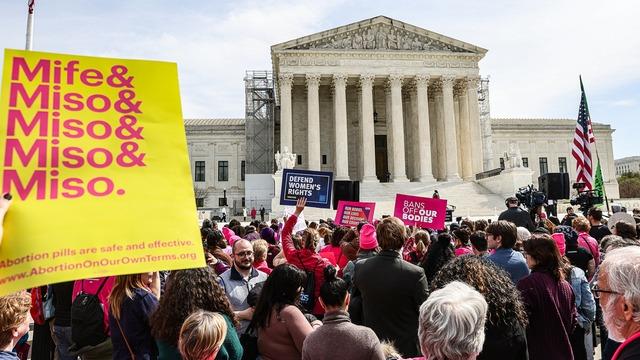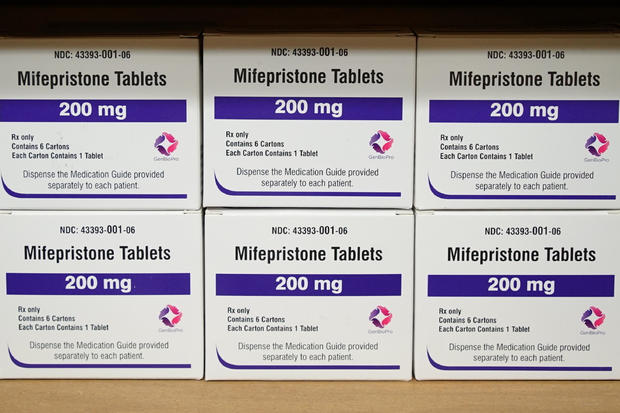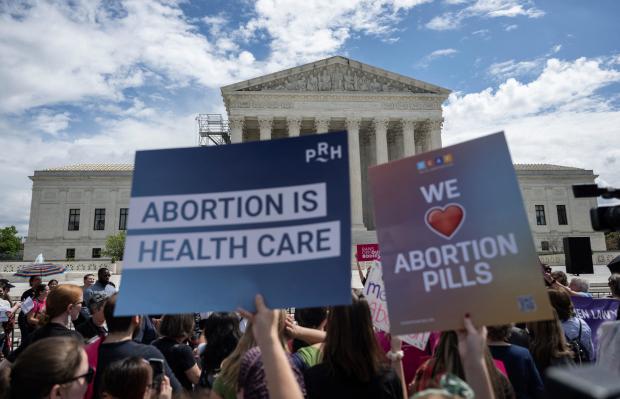▶ Watch Video: Key takeaways from Supreme Court abortion pill arguments
The following preview was published before the Supreme Court heard arguments in the case known as FDA v. Alliance for Hippocratic Medicine. Read coverage of the arguments here.
Washington — Twenty months after the Supreme Court ruled to return abortion policy to the states, the issue will be before the justices again on Tuesday, when they weigh a case that threatens to curtail access to a commonly used drug taken in a medication abortion.
The dispute involves a series of actions that the Food and Drug Administration took beginning in 2016 that made the pill, mifepristone, easier to obtain. A group of medical associations that oppose abortion rights have argued the agency acted unlawfully when it relaxed the rules surrounding mifepristone’s use.
The justices will first have to consider a procedural issue — whether the doctors and their associations have legal standing to challenge the FDA’s efforts in federal court — before deciding whether the FDA’s changes complied with the law.
Hanging in the balance is the availability of the pill nationwide. States that restrict abortion access and those that protect it would all be impacted by a decision that rolls back the FDA’s recent moves.
“We know that reversing the changes made in 2016 and 2021 to access mifepristone will make reproductive care more resource-intensive and less safe,” said Marsha Henderson, former FDA associate commissioner for women’s health, during a call with reporters. “It will also undermine FDA’s congressionally granted authority and confuse patients.
Mifepristone, she said, has been regulated “more strictly and studied more intensely” than more other drugs.
The rise of medication abortions
Medication abortions made up more than half of all abortions in the U.S. in 2023, according to new research from the Guttmacher Institute, an organization that supports abortion rights. The group found that abortions done by pills accounted for 63% of all that took place within the health care system last year, a jump from 2020, when more than 5 in 10 abortions were medication abortions.
The increase in medication abortions in the three-year span followed efforts by the FDA to make mifepristone easier to obtain, namely by allowing it to be sent through the mail. The agency temporarily lifted a requirement that the drug be dispensed in-person during the COVID-19 pandemic, and made the change permanent in late 2021.
The Supreme Court is now reviewing whether the FDA acted lawfully when it made that move, along with several other steps the agency took in 2016 surrounding mifepristone’s use. As part of the 2016 actions, the FDA allowed mifepristone to be taken later in a pregnancy, increasing the gestational age limit from seven to 10 weeks. It also reduced the number of in-person visits required by a patient undergoing a medication abortion from three to one, and allowed more health care providers to prescribe the drug.
“This isn’t just any method of abortion,” said Mary Ziegler, a University of California, Davis, law professor who is a leading historian on the abortion debate in the U.S. Not only is it the most popular, but medication abortion is “one that is uniquely important at a time when abortion is a crime in a lot of places,” she continued.
Twenty-one states have either banned or restricted abortion since the Supreme Court overturned Roe v. Wade in June 2022.
How the case arrived at the Supreme Court
The FDA first approved mifepristone in 2000. It’s taken with a second drug, misoprostol, to terminate an early pregnancy. In the more than 20 years since mifepristone became available in the U.S., more than 5 million women have taken the drug, according to the agency.
Serious adverse events as a result of mifepristone are “exceedingly rare,” the FDA said, and studies show that hospitalization of women who have taken the drug occurs in less than 1% of cases.
But in November 2022 — more than two decades after the FDA green-lighted mifepristone — a group of medical associations that oppose abortion rights filed a lawsuit in federal district court in Texas challenging both the 2000 approval and the more recent changes. The organizations claimed the FDA did not have the authority to approve mifepristone for sale and failed to adequately consider the drug’s safety and effectiveness.
The federal judge overseeing the case, U.S. District Judge Matthew Kacsmaryk, agreed that the FDA’s 2000 approval and subsequent actions were likely unlawful. He blocked the FDA’s initial action allowing the drug to be sold in the U.S.
But Kacsmaryk put his ruling on hold for a week, setting off a frenetic series of decisions from a federal appeals court and the Supreme Court. In April 2023, the high court preserved access to mifepristone while legal proceedings continued.
Months after the Supreme Court issued its emergency relief, the U.S. Court of Appeals for the 5th Circuit upheld the FDA’s 2000 approval of the abortion pill, but said the agency violated the law with its more recent changes to the rules for its use.
The 5th Circuit made clear that its decision was preempted by the Supreme Court’s earlier order protecting access, which remains in effect until the justices issue a ruling in the case.
The Justice Department and Danco Laboratories — the maker of Mifeprex, the brand-name version of mifepristone — asked the Supreme Court to review the 5th Circuit’s ruling, and it agreed to do so in December. A ruling is expected by the end of June.
The arguments in the mifepristone case
Before considering whether the FDA went too far with its 2016 and 2021 changes, the Supreme Court will first weigh whether the medical associations and their members sufficiently showed that they may be injured by the agency’s actions, and that those alleged injuries can be traced to the FDA’s relaxing of the rules for mifepristone.
The Justice Department argued in filings that the doctors involved in the legal challenge do not prescribe the drug and haven’t identified a single case where a member has been forced to complete an abortion for a woman who shows up at an emergency room with an ongoing pregnancy.
The associations’ theory of how one of their members may be harmed rests on a “long and speculative chain of contingencies,” Solicitor General Elizabeth Prelogar wrote. Under their theory, a woman who takes mifepristone must suffer an “exceedingly rare serious adverse event” that requires emergency care. Instead of returning to the provider who prescribed the drug, the woman must then seek care from one of the association members or show up in an emergency room where a member physician is working.
The doctor would only be forced to complete the abortion if another physician wasn’t available to help, or if the member couldn’t invoke federal conscience protections for some reason, Prelogar reasoned.
But lawyers for the Alliance for Hippocratic Medicine told the court that their members object not only to abortion, but also to “complicity in the process.” Even completing a medication abortion when the fetus is no longer alive harms doctors who consider abortion objectionable, said the group, which is represented by the conservative legal organization Alliance Defending Freedom.
“FDA has spent decades directing women harmed by abortion drugs to emergency rooms. Many of them have sought treatment from respondent doctors,” the lawyers wrote. “Now that FDA is called to account for the harm caused, the agency cannot insist that the very treatment option it directed is somehow speculative.”
If the Supreme Court finds that the doctors failed to show they would suffer a concrete injury, the justices would order the case to be dismissed without deciding whether the FDA acted lawfully when it relaxed the rules for mifepristone’s use.
But if they reach the key legal issues in the case, the Justice Department and Danco told the justices that the FDA’s changes were lawful.
The agency relied on a “voluminous body of medical evidence” on mifepristone’s use over decades when it determined that the 2016 changes would be safe, Prelogar wrote. In any event, the district court was wrong to second-guess the determinations that Congress empowered the FDA to make, she said.
“To the government’s knowledge, this case marks the first time any court has restricted access to an FDA-approved drug by second-guessing FDA’s expert judgment about the conditions required to assure that drug’s safe use,” Prelogar wrote.
Lawyers for the physicians countered that the FDA failed to give a “satisfactory explanation” for its decision to lift the in-person dispensing requirement and called the studies the agency relied on “deeply problematic.”
Withdrawing the in-person visit requirement in 2021 eliminated the opportunity for health care workers to screen for ectopic pregnancies and other conditions, the associations argued. In 2016, the FDA removed “interrelated safeguards without studies” that examined the changes as a whole, they continued.
Warnings of chaos
The prospect of the Supreme Court allowing the 5th Circuit’s decision to stand has raised concerns not only about the impact to medication abortion in the future, but also about what would happen to the mifepristone that’s already available.
“One of the possibilities would be that mifepristone access would be limited or potentially eliminated nationwide, and that would create a lot of chaos,” Ziegler said. “Even if the court did what the 5th Circuit is doing or wanted to do, that would cause a lot of issues too because all of the mifepristone on the market would be misbranded and mislabeled, and that would require both Danco and the FDA to take steps to comply with whatever the Supreme Court says.”
Elisa Wells, the founder of Plan C, a website that provides information about how and where to get abortion pills, agreed that if the doctors prevail, it could cause “chaos, fear and harm” to those seeking medication abortions. But she said international telehealth providers and online vendors could help reduce the impact of a decision that unwinds the FDA’s more recent changes.
“There will be an increase in demand and alternate routes of access,” she told CBS News.
One of those organizations, Aid Access, is a major telemedicine provider of mifepristone, and has provided the pills to women across the U.S. Its founder, Dr. Rebecca Gomperts, said new shield laws in six states have allowed her group’s prescribing to be done by domestic providers.
The shield laws offer protections to licensed health care providers in those states who prescribe and send abortion pills to patients living in states where abortion is restricted or banned.
“Doctors have the right to prescribe medication outside of the label, so in that sense, it really doesn’t matter what the Supreme Court says, because that is the discretion of medical providers,” Gomperts told CBS News. “We are just going to continue no matter what the decision is. It won’t affect our work.”
As a backup, Gomperts said Aid Access could always go back to its initial model, in which Gomperts herself prescribed mifepristone remotely from Europe.
“The reality is the pills are not going to go away,” she said. “Women will always get them, and we will do whatever it takes to get them to them.”
Controversy surrounding the case
Separate from concerns about the ramifications of a decision against the FDA, the dispute over mifepristone has been surrounded by controversy since the Alliance for Hippocratic Medicine brought the case 16 months ago.
The lawsuit was filed in Amarillo, Texas, where Kacsmaryk is the lone district judge and was effectively guaranteed to oversee the case. Appointed to the federal bench by former President Donald Trump in 2019, Kacsmaryk had written critically about abortion and Roe v. Wade.
The decision by the medical groups to file their case in Amarillo sparked accusations they engaged in “forum-shopping,” a practice in which a party pursues a claim in the court that’s most favorable to them.
The Judicial Conference of the United States, the policy-making arm of the federal judiciary, announced a new practice earlier this month in which civil cases with statewide and nationwide implications will be assigned at random. The change is meant to curb judge-shopping, according to U.S. Senior District Judge Robert Conrad, secretary of the Judicial Conference.
Studies cited by Kacsmaryk and the 5th Circuit in their rulings in favor of the Alliance for Hippocratic Medicine have also faced scrutiny. The American Civil Liberties Union warned the Supreme Court in a filing that the lower court decisions relied on “patently unreliable witnesses” and “ideologically tainted junk science.”
The group said doctors who submitted declarations during an earlier stage in the case have been criticized by judges in other cases involving abortion restrictions. Also, one study referenced by Kacsmaryk about the mental health impacts of medication abortion relied on 98 anonymous blog posts from women who shared their purported experiences with medication abortion between 2007 and 2018.
Additionally, the publisher of an academic journal retracted two studies from 2021 and 2022 that were cited by Kacsmaryk after a reader raised concerns about the data and whether the authors’ affiliations with organizations that oppose abortion rights presented a conflict of interest.
Two experts reviewed the articles, and they identified issues that “demonstrate a lack of scientific rigor and invalidate the authors’ conclusions in whole or in part,” according to the publisher, Sage Journals.
Haley Ott contributed to this report.





































